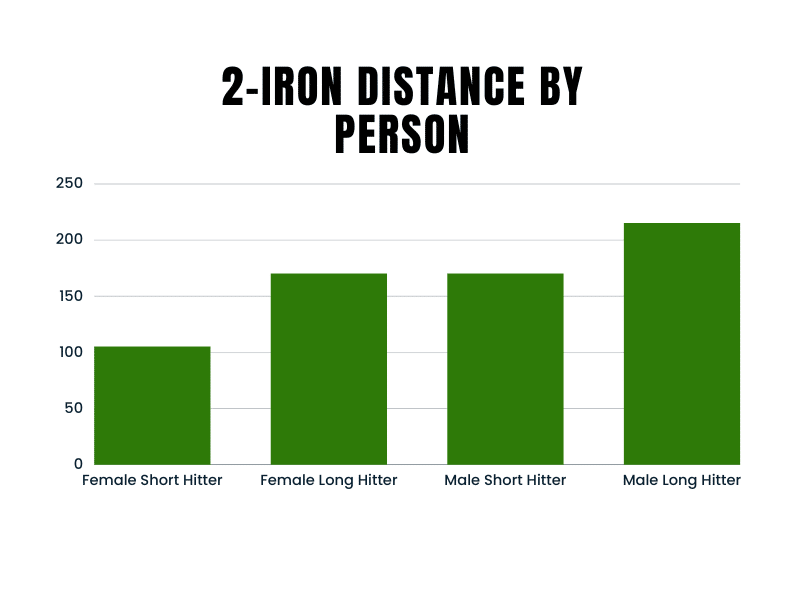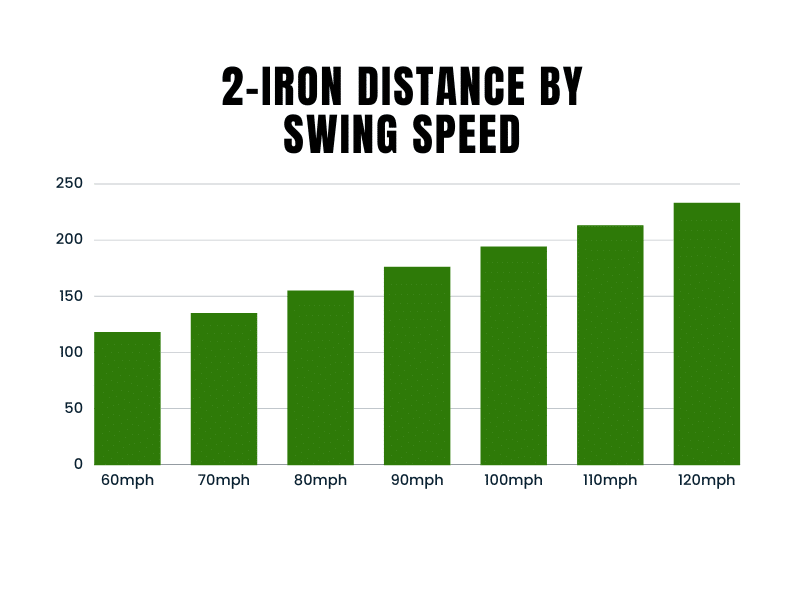Gone are the days of everyone carrying 2-irons. But should they be? While they are tough to hit, they bring advantages to the table that other clubs can’t match.
What is the 2 iron loft? Most 2 irons have a loft of 17 degrees. All are under 20 degrees. This loft angle is designed to produce a low, penetrating ball flight that can travel long distances. However, many modern golfers opt for hybrids or long irons with higher lofts for easier launch and greater forgiveness.
In this post, we’ll take a look at the 2-iron loft, distance, and all of its other characteristics to help you decide whether it should make your golf bag.
2-Iron: Overview
Pros
- Great distance
- Fitting for players with fast swing speeds
- Perfect for windy conditions or overhanging trees
- Precise
- Workable
Cons
- Not very forgiving
- High skill requirement
Who Should Use a 2-Iron?
A 2 iron is typically used by advanced golfers who have a faster swing speed and want to hit long, low shots with a low trajectory.
It can be useful for hitting shots off the tee or from the fairway on long par 4 or par 5 holes.
However, due to the difficulty of hitting a 2 iron consistently, it is not recommended for beginner or intermediate golfers. Instead, they may want to consider using higher lofted clubs, such as hybrids or fairway woods, which are easier to hit and provide more forgiveness.
The Basics of a 2-Iron
What Is a 2-Iron?
The 2-iron sits behind the 1-iron as the second-longest iron. Due to its length, it is extremely difficult to hit it with a safe degree of consistency. As such, it is not a core club that features in most golf sets. The lowest is usually a 3 or 4-iron.
Therefore, if you want a 2-iron, you will likely have to purchase it separately.
What Is the Loft of a 2-Iron?
The loft of a 2-iron is usually at 17 degrees. The standard 2-iron loft is always below 20 degrees,
The two clubs with the closest loft to the 2-iron are the 2-hybrid and the 5-wood. The 2-hybrid has 17 degrees of loft, whereas the 5-wood has 18 degrees of loft.
How 2-Iron Loft Affects Your Shot
As the 2-iron has 17 loft degrees. It will produce a low flight path. Its low spin also reduces carry time and increases the amount of ball roll. This gives you increased yardage in windy conditions.
Read More: How Many Degrees of Loft are Between Irons?
How Far Does a 2-Iron Go?

A 2-iron’s distance is respectable, but to know the range you can expect from this club, you have to get specific regarding what type of player you are.
We all know that men generally hit the ball further than women because of their increased muscle mass. However, skill level and the type of hitter you are other important factors that are at play.
While viewing the distance of a 2-iron by gender and type of hitter is useful, it’s a bit vague. That’s why we’ve put together another graph that compares yardage with swing speed. So if you know your swing speed, it should give you a good estimate of how far you can strike the ball.
If you can hit the ball between 100 and 110 mph, you are doing great! In this range, you should get around 194-213 yards.

Read more: Golf Club Distance for All Skill Levels
What Is the Length of a 2-Iron?
A 2-iron’s length depends on two characteristics: whether it is for a man or woman and whether it uses steel or graphite.
Firstly, let’s tackle gender. It’s pretty simple, really. Men’s 2-irons are an inch and a half longer than the 2-irons for female golfers, assuming they are made from the same material.
As for the material, 2-irons that use graphite shafts are 0.5” longer than those that use steel shafts. From this, we can state that:
- Men’s 2-iron shaft lengths are 40” with graphite
- Men’s 2-iron shaft lengths are 39.5” with steel
- Women’s 2-iron shaft lengths are 38.5” with graphite
- Women’s 2-iron shaft lengths are 38” with steel
Read More: Best Driving Irons
Tips for Maximizing the Benefits of 2-Iron Loft
The 2-iron shines in situations where you need distance but a relatively low flight path. Par 4s are a good example. The likes of a 5-wood may give too much elevation causing you to lose distance.
The slightly lower loft and reduced carry distance of the 2-iron enable it to cut through the wind, and the reduced spin causes more ball roll. While you can use it off the tee, some players also like to use it in certain situations when in the fairways or rough.
Shots that demand workability are another good option to pull out a 2-iron. If you need both distances and want to hit a draw or fade on command, it’s one of the best clubs for the job.
Should You Use a 2-Iron?
As mentioned earlier, 2-irons are not a standard club in golf sets because they are so damn hard to hit. Many players struggle with the likes of 3 and 4-irons, as they are only a little shorter and still have low lofts. So going down to a 2 is even more problematic.
You also have to consider that you are only allowed 14 clubs in your bag which quickly get used up. So if you don’t think that you’ll get much use out of a 2-iron, there is little point in carrying one.
2-iron golf clubs are hard to hit because they have a very small sweet spot. The shorter clubs, many of us are accustomed to offering much higher levels of forgiveness.
That being said, 2-irons certainly have their advantages. Firstly, they get remarkable distance and are very precise, especially for low handicappers with fast swing speeds. They are also one of the best clubs when you want to produce a punch shot, perhaps because of windy conditions or overhanging trees.
How to Hit a 2-Iron
Off the Tee
- Tee the ball up a little lower than you would for a driver — only around a quarter of the ball should be above the center of the clubface
- Place the ball just inside your left heel (if you’re a righty)
- Strike the ball on the downward portion of your swing and choke down on the club if you need additional control
Off the Fairway
- Ensure that the ball is slightly more to the right (around a few inches to the left of the center of your stance)
- Use a similar swing motion to that of a fairway wood
- Keep your club low to the ground on the backswing
- Strike the ball on the downwards portion of the through-swing and create a small divot in the ground
Chipping
Although you won’t see too many golfers reaching for a 2-iron when they want to hit a chip shot, it can be useful in some scenarios. At minimum, you should be facing a decent lie, close to the green, with no obstacles.
- Use a tight grip with no wrist cock
- Depending on your distance from the hole, produce around one-quarter to half of your usual backswing
- Swing in a fairly straight motion
- Your follow-through should match the length of your backswing or be greater
2-Iron vs 2-Hybrid
The 2-hybrid usually has 17 degrees of loft, just like the 2-iron, making it a great replacement if you’re not sold on a 2-iron. While there is plenty of overlap in utility between these two clubs, there are also plenty of differences to be aware of.
For starters, there’s the distance. While both generate great distance, the increased mass of the 2-hybrid will give you a little bit more length. Conversely, the 2-iron generates less spin, which gives it more rollout.
This reduced spin also makes it the clear winner if you want to play a low punch shot. Perfect for windy days where you want maximum distance.
On the other hand, 2-hybrids are far better choices when it comes to forgiveness, which is the deciding factor for many people. You see, while 2-irons offer great utility, there is not much point in using them if you can’t consistently take advantage of this.
2-Iron vs 5-Wood
The 5-wood has one more degree of loft compared to the 2-iron at 18 degrees. While it is somewhat similar to the 2-iron and 2-hybrid, I would say that it has the most differences of the three clubs.
Two of the areas it shines are forgiveness and distance. The larger clubhead gives you far more confidence at address than a 2-iron. This encourages you to really unload. And given the high forgiveness, even if you don’t strike the ball centrally, you can expect a half-decent shot with good distance.
The extra verticality also makes the 5-wood a superb choice for shots where you must clear hazards from a distance. The 2-iron causes the ball to hit the turf much earlier, making it a poor choice in this circumstance. On the other hand, this increased carry time makes 5-woods a poor choice for windy conditions, so there is a trade-off.
Another advertising quality of the 5-wood is its versatility. You can use it virtually anywhere: the tee, rough, or fairway. By contrast, you certainly can’t with the 2-iron. As a result, you can expect to use a 5-wood far more often than a 2-iron which may be reason enough for you to use it instead.
2-Iron vs 3-Iron
A 2 iron and a 3 iron are long irons typically used for hitting long shots from the fairway or off the tee.
However, golfers should consider some differences between the two clubs when deciding which one to use.
The main difference between a 2-iron and a 3-iron is the loft angle. A 2 iron typically has a lower loft angle than a 3 iron, which means it will produce lower ball flight and less spin. This makes it more suitable for experienced golfers with a fast swing speed and want to hit low, penetrating shots that can travel a long distance.
On the other hand, a 3 iron has a slightly higher loft angle than a 2 iron, which makes it easier to get the ball airborne and produce more spin. This makes it a more forgiving club that can be useful for golfers who are not as skilled or who have a slower swing speed.
In general, a 2 iron is a more specialized club that is typically used by experienced golfers who want to hit low, long shots. A 3 iron is a more versatile club that can be used by a wider range of golfers and for various shots.
Ultimately, choosing between a 2 iron and a 3 iron depends on the golfer’s skill level, swing speed, and personal preferences.
Read More: Best TaylorMade Irons
Our Favorite 2-Irons
We have a full write-up on our favorite 2-irons, which may interest you. But for those who want some quick info, here are the clubs we recommend.
TaylorMade P970 UDI — Best Performing
Released in 2021, the TaylorMade P970 was designed in response to comments from PGA Tour players. It’s aimed at those who want more control from their 2-iron without losing distance.
Perhaps the main improvement on the previous model is the increased sweet spot size. TaylorMade claims that the club is up to 60% easier to use. They achieved this by making the body thinner and reallocating 22 g of tungsten weight to the toe.
The build is also 69% lighter overall due to the incorporated SpeedFoam Air Technology. Approximately 3.5 g of weight was repositioned to optimize the ball launch and give the club a satisfying sweet sound.
Mazel Driving Iron — Budget Choice
If you want to give long irons a go but don’t want to invest much money, the 2-iron by Mazel could be a good option. At two figures, it significantly undercuts most other models.
It has a full hollow body design with a low center of gravity due to the added screw on the back. As such, it feels and sounds great, and you get satisfactory distance. The wide sole also helps improve the forgiveness a little, which will be appreciated by players who struggle with long irons (that’s most of you!).
The drawbacks are that it’s not as high performing as some of the more expensive models and has a rather plain appearance. However, considering the price, these drawbacks are largely inconsequential in our opinion.
FAQs
Does a 2-Iron Go as Far as a Driver?
Drivers produce considerably more distance than 2-irons. On average, players hit drivers 250-320 yards, whereas they hit 2-irons 170-200 yards.
Is a 2-Iron the Same as a 5-Wood?
Although 2-irons and 5-woods are similar in terms of loft and distance, they bring different benefits to the table.
The 5-wood produces more spin and has more carry time. This makes it excellent for clearing hazards from a distance.
On the other hand, 2-irons have less spin and carry time with more ball roll. This makes them better for punch shots.
What Club Does a 2-Iron Replace?
The 2-iron most commonly replaces a 2-hybrid or 5-wood. While true, you could carry a 2-iron and 5-wood if you wanted to.
What Degree is a 2-Iron?
Typically, a 2-iron has 17 degrees of loft. However, it can be as low as 16 or as high as 20.
Final Thoughts
For most golfers, the 2-Iron probably won’t make the bag due to how difficult it is to use. Therefore the 2-hybrid or 5-wood are probably better choices. That being said, we recommend you at least try a 2-iron to see how you perform with it. The 2-iron’s loft and low spin can be very useful. If you’re a low handicapper, it could offer you something that your other clubs just don’t. Tiger Woods himself recently made the switch from his 5-wood.
Alex’s routes in sports began with football and now mostly focuses on ping pong and golf. Alex loves the strategy and is always looking for a competitive edge. This is what drove him to write strategy guides and product reviews. He takes great pride in spreading his knowledge and loves to coach fellow players. You can connect with him on LinkedIn, IG, FB, or alexhorscroftwriting@gmail.com.






